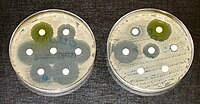
Photo from wikipedia
Fecally contaminated waters can be a source for human infections. We investigated the occurrence of fecal indicator bacteria (E. coli) and antibiotic-resistant E. coli, namely, extended spectrum beta-lactamase (ESBL)-producing E.… Click to show full abstract
Fecally contaminated waters can be a source for human infections. We investigated the occurrence of fecal indicator bacteria (E. coli) and antibiotic-resistant E. coli, namely, extended spectrum beta-lactamase (ESBL)-producing E. coli (ESBL-EC) and carbapenemase-producing E. coli (CP-EC) in the Dutch–German transboundary catchment of the Vecht River. Over the course of one year, bacterial concentrations were monitored in wastewater treatment plant (WWTP) influents and effluents and in surface waters with and without WWTP influence. Subsequently, the GREAT-ER model was adopted for the prediction of (antibiotic-resistant) E. coli concentrations. The model was parametrized and evaluated for two distinct scenarios (average flow scenario, dry summer scenario). Statistical analysis of WWTP monitoring data revealed a significantly higher (factor 2) proportion of ESBL-EC among E. coli in German compared to Dutch WWTPs. CP-EC were present in 43% of influent samples. The modeling approach yielded spatially accurate descriptions of microbial concentrations for the average flow scenario. Predicted E. coli concentrations exceed the threshold value of the Bathing Water Directive for a good bathing water quality at less than 10% of potential swimming sites in both scenarios. During a single swimming event up to 61 CFU of ESBL-EC and less than 1 CFU of CP-EC could be taken up by ingestion.
Journal Title: Environmental Science & Technology
Year Published: 2022
Link to full text (if available)
Share on Social Media: Sign Up to like & get
recommendations!